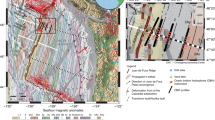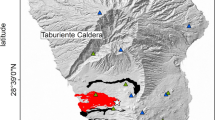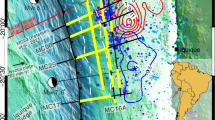Abstract
Plate tectonics successfully describes the surface of Earth as a mosaic of moving lithospheric plates. But it is not clear what happens at the base of the plates, the lithosphere–asthenosphere boundary (LAB). The LAB has been well imaged with converted teleseismic waves1,2, whose 10–40-kilometre wavelength controls the structural resolution. Here we use explosion-generated seismic waves (of about 0.5-kilometre wavelength) to form a high-resolution image for the base of an oceanic plate that is subducting beneath North Island, New Zealand. Our 80-kilometre-wide image is based on P-wave reflections and shows an approximately 15° dipping, abrupt, seismic wave-speed transition (less than 1 kilometre thick) at a depth of about 100 kilometres. The boundary is parallel to the top of the plate and seismic attributes indicate a P-wave speed decrease of at least 8 ± 3 per cent across it. A parallel reflection event approximately 10 kilometres deeper shows that the decrease in P-wave speed is confined to a channel at the base of the plate, which we interpret as a sheared zone of ponded partial melts or volatiles. This is independent, high-resolution evidence for a low-viscosity channel at the LAB that decouples plates from mantle flow beneath, and allows plate tectonics to work.
This is a preview of subscription content, access via your institution
Access options
Subscribe to this journal
Receive 51 print issues and online access
$199.00 per year
only $3.90 per issue
Buy this article
- Purchase on Springer Link
- Instant access to full article PDF
Prices may be subject to local taxes which are calculated during checkout




Similar content being viewed by others
References
Rychert, C. A., Rondenay, S. & Fischer, K. M. P-to-S and S-to-P imaging of a sharp lithosphere-asthenosphere boundary beneath eastern North America. J. Geophys. Res. 112, B08314 (2007)
Kawakatsu, H. et al. Seismic evidence for sharp lithosphere-asthenosphere boundaries of oceanic plates. Science 324, 499–502 (2009)
Parsons, B. & McKenzie, D. Mantle convection and the thermal structure of plates. J. Geophys. Res. 83, 4485–4496 (1978)
Watts, A. B. Isostasy and Flexure of the Lithosphere (Cambridge Univ. Press, 2001)
Fischer, K. M., Ford, H. A., Abt, D. L. & Rychert, C. A. The lithosphere-asthenosphere boundary. Annu. Rev. Earth Planet. Sci. 38, 551–575 (2010)
Naif, S., Key, K., Constable, S. & Evans, R. L. Melt-rich channel observed at the lithosphere–asthenosphere boundary. Nature 495, 356–359 (2013)
Olugboji, T. M., Karato, S. & Park, J. Structures of the oceanic lithosphere-asthenosphere boundary: mineral-physics modeling and seismological signatures. Geochem. Geophys. Geosyst. 14, 880–901 (2013)
Jarchow, C. M., Goodwin, E. B. & Catchings, R. D. Are large explosive sources applicable to resource exploration? Leading Edge (Tulsa Okla.) 9, 12–17 (1990)
Steer, D. N., Knapp, J. H. & Brown, L. D. Super deep reflection profiling: exploring the continental mantle lid. Tectonophysics 286, 111–121 (1998)
Henrys, S. A. et al. SAHKE geophysical transect reveals crustal and subduction zone structure at the southern Hikurangi margin, New Zealand. Geochem. Geophys. Geosyst. 14, 2063–2083 (2013)
Lamb, S. H. Cenozoic tectonic evolution of the New Zealand plate-boundary zone: a paleomagnetic perspective. Tectonophysics 509, 135–164 (2011)
Reyners, M., Eberhart-Phillips, D., Stuart, G. & Nishimura, Y. Imaging subduction from the trench to 300 km depth beneath the central North Island, New Zealand, with Vp and Vp/Vs. Geophys. J. Int. 165, 565–583 (2006)
Eberhart-Phillips, D., Reyners, M., Chadwick, M. & Chiu, J.-M. Crustal heterogeneity and subduction processes: 3-D Vp, Vp/Vs and Q in the southern North Island, New Zealand. Geophys. J. Int. 162, 270–288 (2005)
Warner, M. Free water and seismic reflectivity in the lower continental crust. J. Geophys. Eng. 1, 88–101 (2004)
Bostock, M. G. Seismic waves converted from velocity gradient anomalies in the Earth’s upper mantle. Geophys. J. Int. 138, 747–756 (1999)
Zhou, H. Practical Seismic Data Analysis (Cambridge Univ. Press, 2014)
Sheriff, R. E. & Geldart, L. P. Exploration Seismology 2nd edn (Cambridge Univ. Press, 1995)
Warner, M. & McGeary, S. E. Seismic reflection coefficients from mantle fault zones. Geophys. J. Int. 89, 223–230 (1987)
Hacker, B. R., Abers, G. A. & Peacock, S. M. Subduction factory 1. Theoretical mineralogy, densities, seismic wave speeds, and H2O contents. J. Geophys. Res. 108 (B1). 2029 (2003)
Yamamoto, J., Korenaga, J., Hirano, N. & Kagi, H. Melt-rich lithosphere-asthenosphere boundary inferred from petit-spot volcanoes. Geology 42, 967–970 (2014)
Sakamaki, T. et al. Ponded melt at the boundary between the lithosphere and asthenosphere. Nature Geosci. 6, 1041–1044 (2013)
Hirth, G. & Kohlstedt, D. L. Water in the oceanic upper mantle: implications for rheology, melt extraction and the evolution of the lithosphere. Earth Planet. Sci. Lett. 144, 93–108 (1996)
Hammond, W. C. & Humphreys, E. D. Upper mantle seismic wave velocity: effects of realistic partial melt geometries. J. Geophys. Res. 105, 10975–10986 (2000)
Gripp, A. E. & Gordon, R. G. Young tracks of hotspots and current plate velocities. Geophys. J. Int. 150, 321–361 (2002)
Hall, C. E. & Parmentier, E. M. Spontaneous melt localization in a deforming solid with viscosity variations due to water weakening. Geophys. Res. Lett. 27, 9–12 (2000)
Lie, J., Pederson, T. & Husebye, E. S. Observations of seismic reflectors in the lower lithosphere beneath the Skagerrak. Nature 346, 165–168 (1990)
Richardson, R. M. Ridge forces, absolute plate motions, and the intraplate stress field. J. Geophys. Res. 97, 11739–11748 (1992)
Savage, M., Park, J. & Todd, H. Velocity and anisotropy structure of the Hikurangi subduction margin, New Zealand, from receiver functions. Geophys. J. Int. 168, 1034–1050 (2007)
Duncan, G. & Beresford, G. Median filter behaviour with seismic data. Geophys. Prospect. 43, 329–345 (1995)
Taylor, J. R. An Introduction to Error Analysis 2nd edn (University Science Books, 1997)
Menke, W., Levin, V. & Sethi, R. Seismic attenuation in the crust at the mid-Atlantic plate boundary in south-west Iceland. Geophys. J. Int. 122, 175–182 (1995)
Badley, M. E. Practical Seismic Interpretation (International Human Resources Development Corporation, 1985)
Williams, C. A. et al. Revised interface geometry for the Hikurangi Subduction Zone, New Zealand. Seismol. Res. Lett. 84, 1066–1073 (2013)
Seward, A. et al. Seismic Array HiKurangi Experiment II (SAHKE II) (Onshore Active Source Acquisition Report no. 2011/50, GNS Science, Lower Hutt, 2011)
Larsen, S. & Schultz, A. ELAS3D:2D/3D Elastic Finite-difference Wave Propagation Code (Lawrence Livermore National Laboratory Technical Report UCRL-MA-121792, 1995)
Acknowledgements
The SAHKE project was supported by public research funding from the Government of New Zealand, the Japanese Science and Technology Agency, and the National Science Foundation (NSF OCE-1061557). Explosives and technical support was provided by Orica New Zealand Ltd. Individual land owners, Greater Wellington Regional Council, Transpower, and forestry companies allowed us onto their land. The IRIS/Passcal instrument pool provided the land instruments and technical support. We thank colleagues E. Smith and W. Stratford for comments on initial versions of this paper.
Author information
Authors and Affiliations
Contributions
All authors except J.N.L. and S.L. participated and led aspects of the data acquisition. J.N.L. developed and applied the median filter to produce Fig. 3a and Extended Data Fig. 5a, c. T.A.S. wrote the initial manuscript. S.A.H. organized the shots and permissions, and did processing for the pick migrations and the raw stack (Extended Data Figs 2 and 5b). D.O. and H.S. developed the initial shot gathers from the raw instrument data. T.A.S. and J.N.L. carried out numerical modelling (Fig.4b, Extended Data Figs 1d, 6 and 9). All authors discussed and commented on various versions of the manuscript.
Corresponding author
Ethics declarations
Competing interests
The authors declare no competing financial interests.
Extended data figures and tables
Extended Data Figure 1 Frequency spectra and analysis.
a, Frequency spectrum of the R2 reflection and the background noise. We only show frequencies above the 4.5-Hz cut-off frequency of the geophones used. b, Frequency spectrum of the R0 and R2 reflections. c, Table summarizing the frequency range for all events on the different shots; summaries of the geological conditions in each shot hole34 are also given. d, A spectral ratio analysis16 between R2 and R0 reflections that yields a least squares linear fit to the data to give a gradient of −0.0627. Theoretically this gradient value can be equated to πΔt/QP (ref. 16), where Δt is the TWTT between the R0 and R2 reflectors. For Δt = 20 s, we get an estimate of QP (inverse attenuation) of 1,002 with a standard error of ±30 (based on least squares linear regression).
Extended Data Figure 2 Pick migration for R1 reflector and shot gathers.
a, Plan view of onshore and offshore SAHKE lines with shots 11 and 12 labelled. b, Pick migrations for R1 reflection for shot 11 based on a laterally varying velocity model, which is derived from earthquake and shot data10. We use the velocity model created by 3D tomography to carry out a migration of reflection picks10. Where the arcs converge to a constant solution gives the best structural interpretation of the reflector. We show the results for two shots (b, shot 11; c, shot 12) and the common solution. The solution (black bar) appears to be a reflector in the mantle of the Australian plate, which dips to the southeast and is located within the Taranaki Fault Zone. d, Shot gather for shot 11 with low band-pass filter of 5–10 Hz that brings out the low frequency, R1, southeast-dipping reflector (20 s depth at zero offset). It also shows the R0 reflector (∼9 s at zero offset) for the top of the plate that dips to the northwest. Vertical axis is travel time (s) and horizontal axis is shot offset in km. Sg is the crustal refracted S wave. e, Shot gather for shot 11 with band pass filter 16–30 Hz that shows up the R2 reflector with its broad frequency content, and suppresses the low frequency R1 reflection. Rsed and PmP represent reflections interpreted to come from the upper surface of the sediment channel on top of the oceanic crust, and from the Moho of the oceanic Pacific plate, respectively.
Extended Data Figure 3 Two shot gathers from each line end showing reflections R0 to R3.
a, Shot 12; b, shot 3. Both plots show data that have been band-passed between 8 and 25 Hz. The quality of the shots is highly dependent on the rock that the shot was placed in, with the drillers’ logs34 showing basement rock for shots 9, 10 and 11, and the very bottom of shot hole 12.
Extended Data Figure 4 Stacking and model sensitivities.
a, Stacking chart for image shown in Fig. 3a. Colour scale shows magnitude of the fold, orange stars are shot points. Numbers on the grid are metres north and east from the New Zealand Map Grid. b, Plots of seismic velocity versus depth12 and of stacking velocity (the root-mean-squared average seismic velocity between the surface and a specific depth) versus depth used in the processing of the seismic section (Fig. 3). c, Plot of predicted plate thickness versus average vP for the oceanic mantle; four plots are shown, each one derived using a different value of average crust vP (labelled). Based on the position in travel time for the reflectors at zero offset on shot 11 (Extended Data Fig. 2c), we take the travel time in the oceanic crust to be 4 s and that in the oceanic mantle lid to be 14 s. The green dashed box represents the preferred range of solutions based on likely velocities for the oceanic crust and oceanic upper mantle19. Note that the uncertainty in the thickness of plate determination is < ± 1 km.
Extended Data Figure 5 Stacking tests.
a, Stack as for Fig. 3a but without shot 11. This is a check to ascertain how much the high-quality, higher-frequency shot 11 dominated the stack. We still see the main features in this stack, suggesting that the other shots are making a significant contribution. Dashed line shows our interpreted position for the Moho of the oceanic Pacific plate (PmP reflection). b, A stack with no median filter applied.
Extended Data Figure 6 Wave-equation modelling for a dipping plate model.
a, A model that simulates a highly simplified (oceanic crust not included) SAHKE structure for input into wave equation modelling. A layer of low-wave-speed sediments is included at the base of the crust, so we can examine how multiples from this channel interfere with the proposed R2 and R3 reflections at the base of the plate. The simulation is based on e3d35 and is run with vS = 0, so no S-wave reflections are created. b, Synthetic shot gather for shot 11 geometry based on the model. Ra. M
Extended Data Figure 7 Pre-stack depth migration tests.
a, The two azimuths used for 3D Kirchoff-sum, pre-stack depth migration16 are in-line with the seismic line and at right angles to it (the cross-line). The velocity model used was an earlier version of that shown in Extended Data Fig. 5b with slightly lower velocities. The input shot gathers for 3D migration were the instantaneous amplitude-attribute traces, heavily smoothed by median filtering as in Fig. 3b, then bandpass filtered to produce an approximate zero-phase, low-frequency wavelet at each pre-stack reflection with strong amplitude. b, The in-line migration, showing coherency in the top 30 km with the dip of the top of the plate evident. Here constant travel-time diffraction arcs are created from each shot point. Where energy is enhanced we interpret there to be reflectors, and conversely if there is no enhancement, but just the diffraction arcs, we interpret this to be a lack of coherent structure. Coherent energy is seen at greater depths (90–100 km), which we ascribe to structure of the LAB. c, Here the data of each shot gather are randomized (jack-knife test16), and put through the same migration. Comparing the randomized with the correct data migration shows what are artefacts of the migration geometry, and what is signal. This confirms that images between 90 and 100 km depth seen in b are real. d, Result of migration in the cross-line direction; no coherent alignments are seen. e, Jack-knife test for the cross-line migration. Note that e looks similar to d, suggesting there is no alignment of structure in the cross-line direction, and that the reflections we are imaging are not side-swipe from out of plane structures. f, Schematic plot showing the relationship between the normalized thickness of the acoustic impedance transition zone, d/λ, and the relative (that is, normalized to the value for a vanishingly thin transition zone) reflection coefficient. Here d is the thickness of the zone, λ is the seismic wavelength, and the reflection coefficient is normalized to that for a impedance contrast of zero thickness14. Inset, schematic of the transition zone d between two layers of different velocities, v1 and v2.
Extended Data Figure 8 Gathers for shot 11 where the offsets are plotted in-line and cross-line.
In a, the maximum offset from the shot is 70 km in a northwest to southeast azimuth (see Extended Data Fig. 7a). In b, the maximum offset of seismic receivers from shot 11, in a southwest to northeast azimuth, is 7.5 km. These are gathers of median filtered data (0.5 s by 41 traces), smoothed and passed through a 8–25 Hz bandpass filter, plotted in the 24–32 s range to bring out the R2 and R3 reflectors. Note the coherency in the in-line direction and lack of coherency in the cross-line gather. This further corroborates evidence from the pre-stack depth migration that the R2 and R3 reflections come from a surface below the northwest–southeast striking SAHKE04 line and are not side-swipe from out of plane reflections.
Extended Data Figure 9 Models.
a, Model of the structure and seismic velocities just north of the SAHKE line based on receiver functions28. Note the proposed subduction channel of accreted sediments, in line with more recent work10, and the interpreted 13° dip, which is in the 12°–15° range proposed in this study. b, A simple horizontal-layered model which is used as input for the synthetic wave equation modelling using software e3d35 shown in c. This is a simplified approximation model for our observations beneath SAHKE04, although we ignore dip. c, Wave equation modelling35 based on input modelling shown in b for an input P wave and vertical geophones. No gain control is applied. Strong primary reflections and multiples from the top of the plate and oceanic Moho are shown. In reality, the surface multiples are not that strong because of scattering from topography. The R2 and R3 reflections can be seen as being weak events compared to R0. d, Wave equation modelling35 based on input modelling shown in b for a input S wave and vertical geophones. Here the S-wave reflections are more prominent and S–P converted phases of R2 and R3 are predicted at about 38 and 41 s. Note that the S–P and S–S reflections have no energy at zero incidence angle and significant energy only for offsets >30 km. As we are only stacking data with maximum offsets of 50 km, we expect that some, but limited, S–P energy is contributing to the R4 phase of Fig. 3a.
Rights and permissions
About this article
Cite this article
Stern, T., Henrys, S., Okaya, D. et al. A seismic reflection image for the base of a tectonic plate. Nature 518, 85–88 (2015). https://doi.org/10.1038/nature14146
Received:
Accepted:
Published:
Issue Date:
DOI: https://doi.org/10.1038/nature14146
This article is cited by
-
Distinct slab interfaces imaged within the mantle transition zone
Nature Geoscience (2020)
-
Melting of recycled ancient crust responsible for the Gutenberg discontinuity
Nature Communications (2020)
-
Discovery of flat seismic reflections in the mantle beneath the young Juan de Fuca Plate
Nature Communications (2020)
-
Deep electrical imaging of the ultraslow-spreading Mohns Ridge
Nature (2019)
-
Three-dimensional variations of the slab geometry correlate with earthquake distributions at the Cascadia subduction system
Nature Communications (2018)
Comments
By submitting a comment you agree to abide by our Terms and Community Guidelines. If you find something abusive or that does not comply with our terms or guidelines please flag it as inappropriate.



